Do you want to learn how to solder? Do you want to make really cool things? Do you want to teach other people how to solder (and make cool things too)?
I’m happy to announce the release of Soldering is Easy, a comic book that will teach anyone the basics of soldering.
This seven page comic book explains in detail and with pictures how to make a good solder connection. It also teaches you all the other bits and pieces of knowledge that you need to successfully solder together an electronic kit, even if you’ve never soldered before!
I worked with Mitch Altman (@maltman23) and Andie Nordgren to create this revised and extended version of the wildly popular one page handout that Mitch and Andie created in 2010.
The comic (and lots more cool stuff!) will be included in a book that Mitch and I are writing about How to Make Cool Things with Microcontrollers (For People Who Know Nothing). It will be published by No Starch Press.
Here’s a sample page (click for a bigger version):
As of 2015 the comic book has been translated into 21 other languages! A huge thanks to everyone who sent in translations and is helping us spread our message around the world! We would love for people to translate the comic book into more languages! If you create a translation, please post a comment here and I’ll link to it! If you’re looking for help with a translation, you can try posting in the forums.
The comic is released under a Creative Commons license (Attribution-ShareAlike), so you are free to teach with it, color it, modify it, share it with your friends, translate it, and basically do whatever you like with it!
English:
The complete comic book is available for download here:
“Soldering is Easy” Comic Book (PDF)
We also have some other versions of the comic available:
- FullSolderComic.mobi – Amazon Kindle version by bloo
- ePub version by Hal Motley (contributed Feb 18, 2018)
- FullSolderComic_Booklet_11x17_EN.pdf – An 11×17 version that you can fold into an actual comic book (with 8.5×11 pages).
- FullSolderComic_Images_20110409.zip – 300 DPI images of each page
- FullSolderComic_NoText_20110409.zip – 300 DPI images without text (for translation)
- A PDF version without text is also available.
- FullSolderComic.zip – the Comic Life source file used to create all of the other versions. This is probably the best place to start if you are making a translation, but you’ll need a Mac and a copy of Comic Life.
Translations:
Special thanks to Alexander Bodora for creating the original version of this table!
And really, soldering is easy (and fun!). Learn how to solder and teach your friends!

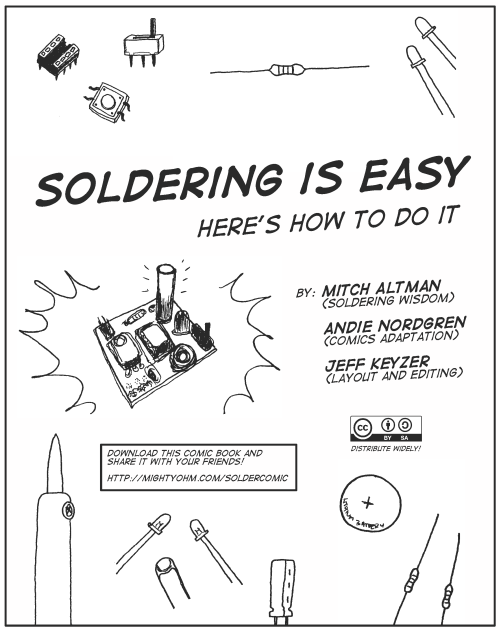
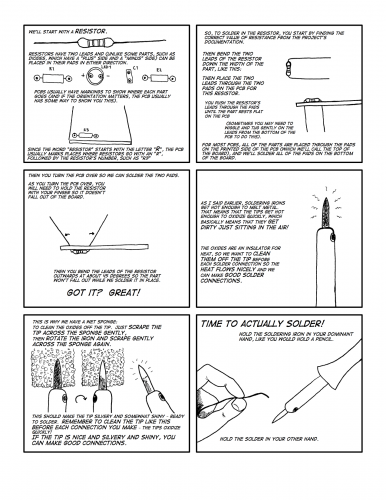


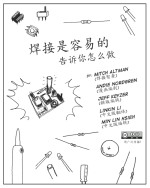

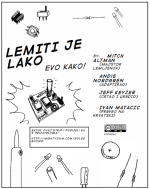
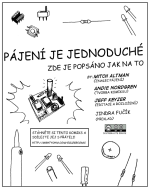


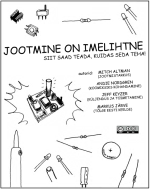



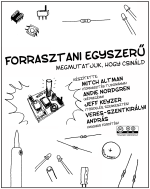
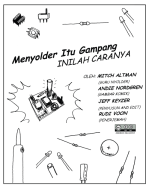



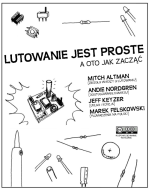

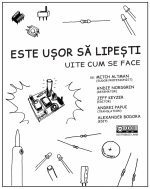



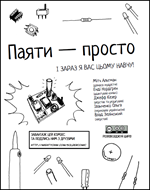
Hey Jeff! Yet another translation finished!!, this time of the old single page comic to spanish.
I have to tell you that I’ve passed the full spanish comic to my cousin, and today for his 14th birthday I gave him a toolbox-kit full of the basic tools for learning electronics and soldering. In no time he’ll be making his own electronics projects and in a big part because of your awesome comic.
I also gave him a writer user on my blog, so I’ll encourage him to post his projects and progress in electronics.
Hope you like it!, pass the word to mitch!
http://www.megaupload.com/?d=3DM1QIJ2
Cheers!
SGTECH,
Thank you for yet another excellent translation and your inspiring words!!
I sent the translation to Mitch, so he can post it on his site along with the other translations, at:
http://www.tvbgone.com/cfe_mfaire.php
Thank you!
Jeff
Hi, I translated to Japanese.
Thanks for interesting comic!!
Yoshihiro,
Thank you very much for translating the Solder Comic into Japanese!
I will post this on the blog shortly!
Jeff
First of all, i find this VERY VERY usefull! thanks a lot for doing
something like this. and i have a nice idea in mind. you see, im from the
IEEE student branch here in chile, and i would like to promote your comic
in our webpage, and have a printed version for the people here. ¿would be
any trouble if i do that? thanks a lot anyway 😉 (also, ¿will the book be e-released?, i doubt it will reach here and i want it.)
I’ll see what we can do about releasing the book in e-formats, thanks for the suggestion!
The comic is released under the Creative Commons By Attribution Share-Alike license, which means that you can do a lot as long as you credit the original authors (us) and share any derivative works under the same license. More info: http://creativecommons.org/licenses/by-sa/3.0/
Based on your comment I would say that your plans for the comic are totally ok and awesome!
GERMAN TRANSLATION – UPDATE
Main focuses of translation (orderless):
– picture critical text fitting
– doing justice to the german accuracy
– keeping text short
– writing in a newbie and child appropriate way
– keeping the jokes and fun parts alive (not getting lost in translation)
Im on page 5 with the german version. I have to say, that it’s harder than I expected. Not because of the actual translation but because of refitting the german text back into the comic. The issue is that german in length is about 1.75 to 2 times longer (meaning you need more letters and words to say the same). But therefore its amazingly more accurate than english.
I also had to do some editing of my own. But only to the extent, that I added value information or clarified something that would otherwise sound like jibberish in a 1-to-1 translation from english. I never deducted anything from the orginal comic.
Example 1: The german word for “solder” already contains the implication that it is a metal! Thus the extra statement “which is a metal” would not make sense in german. So I added the information that it is a “composition of differnt metals” als clarification for those total newbies (especially children).
Example 2: The word for the soldering pads on the PCB is depending on the Technology used. For THT it would be “Lötaugen” (=Soldereyes) and for SMT it would be “Lötflächen” (=Solderfields). Since the word “Pads” would not be sufficient enough of an explanation I took the liberty to translate it using both german terms and clarifiying its usage depending on the Technology used.
German language is highly self-explanatory. It’s like LEGO (you have a limited amount of basic stones from which you can build endless things that reveal themselves). There are about 8000 independant words you just gotta know and everything else is dumbfoundedly a combination of these words. Therefore a lot of the explaining sentences necessary in the english language would be just dumb repetition of the before sentence if translated 1-to-1.
I found myself in this situation so many times I just added more detailing information to fill the spacing in some places that are picture critical. In most other places, like said above, there was way less space than actually needed.
Translating from german into english is rediculously easy compared to this, because it’s like translating from a detailed description to a generalization (i.e.: “oh that’s a cow sitting on a apple three” = “oh that’s an animal on a plant”).
I hope Mitch, Andie and Jeff approves these alterations and neccesary changes. Otherwise I don’t know any other way of translating that would work!
I already had to rephrase many sections to make them shorter so they’d fit into the boxes! I challenge anyone doing that without any informational loss – it’s not easy! But being a native english and german speaker makes the whole challenge a bit more easier.
ESTIMATION: I’ll be done tonight – Upload tomorrow!
P.S.: Anyone who wants to participate in my translation version, such as Nils Hitze is welcome to proof-read and edit-submit rephrases that either shorten the length while keep the actual informational content or additional clarification information in sections that allow such additions or even make them necessary. These will be added into a new version that will be submitted again to the site. So wait for me to upload mine tomorrow and then get to work and send me an email with the changes as well as your name.
P.P.S.: Besides that feel free to work on and publish a alternating version – My translation ain’t the is-all, end-all!
Btw: Mitch and Jeff you two have very typical german surnames.
Altman = Old+man
Keyzer = probably an english adaptation from the german word “Kaiser” which means Emperor or King-of-Kings in german. Originally a variation from the latin word ruling title which is pronounces in german “ZAETZAR”.
I could not contribute a useful translation of your great comic so I thought an entertaining one would do. http://mtsutro.org/u/sfbm
Well this is bizarre. The shortlink works if you access it directly, but clicked here it redirects to the wrong place. I will have to hit the logs later but in the meantime, here is a proper hyperlink.
http://www.mountsutro.org/images/content/mightyohm_soldering-is-easy_sfbm.png
SPANISH TRANSLATION DONE FOLKS!
SOLDAR ES FACIL!
Here’s the link to the PDF:
http://www.megaupload.com/?d=7CW2IUHO
Cheers!
I’ll post this tomorrow! Thanks again!
Alrighty then Jeff, but just for the sake of it I’ve done another version that includes my name in the last page, and Hiperlinks to the sites of the three of you.
I didn’t made this translation for recognition or anything but only because the comic really engaged me and stroke very deep on my geekyness.
Anyways Here’s the new link. Feel free to post either one.
http://www.megaupload.com/?d=3SXV85ZR
Posted!
Hi Jeff, Great Comic!
I’ve translated into Bahasa Indonesian!
http://ruditronics.wordpress.com/2011/04/21/soldering-is-easy-menyolder-itu-gampang-indonesian-translation/
PDF file:
http://ruditronics.files.wordpress.com/2011/04/menyolderitugampang.pdf
Cheers!
Posted! Thank you for translating!
Announcement: Okay, I guess I’m volunteering to translate the book into german!
Please do! We are desperately in need of a German translation!
I’ve finished the Portuguese Brazil version!
http://hackzilian.com/quadrinhos-tutorial-de-como-soldar-em-portugues
Images on flickr
http://www.flickr.com/photos/tuukul/sets/72157626408768135/
PDF on GoogleDocs
http://bit.ly/ComoSoldar
Xinchejian is also working on French version 😉 Stay tuned!
Here’s the Simplified Chinese version, the prices for tools have been adapted with prices in Chinese yuan in China.
PDF file (4MB):
http://xinchejian.com/?attachment_id=884
Comic Life file (2.4MB):
hhttp://xinchejian.com/?attachment_id=885
Will post a Traditional Chinese version soon…
Nice work! I’ll post it on the blog. Thank you!
Hi! great work!
I’m already translating to portuguese Brazil! When I’m finished I’ll review and send to you!!
Thanks!
Hello, looks like a terrific presentation….was soldering from a young age and want my little guys to know too, will this be in E-Book format? Thanks!
Are you referring to the comic or the book?
If you are looking for the comic in E-book format: I’m not familiar with what E-book formats are out there, can you give me an example or offer to do the conversion for us?
Just found this on LifeHacker.com and saved to my archives, material like this makes it much easier for me to learn! Thank you!
Great job, guys! I’ve done russian translation: http://issuu.com/atarity/docs/soldering_is_easy_rus
Atarity,
Congratulations! You have created the 1st translation (that I have seen!) of the solder comic! 🙂
I’ll post a link to this in the original post shortly.
Thank you!
Jeff
Thanks. Clear, simple and thorough.
I’m from XinCheJian, a hackerspace in Shanghai. We’re working on Chinese version of this book, it should be finished in a few days, I’ll post the link ASAP.
XinCheJian – Thank you from all of us! I will be happy to provide a link to your translation along-side the original version. Let me know when you are finished. 🙂
I was always taught to clean the soldering iron, then dab a tiny amount of solder onto it. This gives the iron a “liquid edge” which means it touches the pad and the lead with a greater surface, which ensures the heat is transferred (evenly and quickly). In truth, simple joints work either way, but more difficult ones benefit from this technique.
Also, I was taught to look at the shape of the solder join when it’s cold. If the join has a sort of inverted curved pyramid shape around the lead, then it’s good (because the solder has properly wetted the joint), but if it’s sort of a blubous outwardly curved shape, then there’s a good chance the joint is dry (and although it may work now, it’ll probably fail in the future).
Either way, this and the one-page version of it are great guides – thanks!
I agree with (and practice) both of these things.
A lot of times a good solder joint is described as a “hershey’s kiss” but we didn’t include that language because we figured it is only in common use in the United States.
Applying a small amount of solder to the tip before making a solder connection can make a big difference, but it is a subtle technique and probably not necessary for an absolute beginner. It takes a while to know when to do it and how much solder to add. Just feeding inches of solder into the tip will not achieve the desired effect. 🙂
thanks @maltman23 , i see your link for this page on twitter
regards,
mizzi
awesome job! I’m working on the spanish translation, it might take me a while though…
I just posted the Comic Life source file, maybe this will help??
Anyway, thank you for translating the comic, and when you finish, please post a comment so I can link to your translation!
Hi Junai_C
If you need help with the Spanish translation, send an email to nombreapellido@gmail.com (sín la tilde)
Regards
Hey Juani and Andres! I was going to put myself to work on the spanish translation too. Maybe we can collaborate on it so it doesn’t take that much. Also I have a lot of comic fonts to make it look exactly as the original and I can handle myself on the corel thingy.
Anyways, please send me an e-mail, tweet or whatever.
sebastiangajate@yahoo.com.ar
twitter.com/SGTECH
See ya!
Hey guys! Listen, I had some time out this days, so I put myself to work and finished translating the whole comic. I don’t want this to be seen as a competition but a collaboration, so, if any of you have a correction or suggestion, please fell free to tell me so.
Here’s the link to the PDF:
http://www.megaupload.com/?d=7CW2IUHO
Cheers!
Good work! Soldering really is easy!
🙂
Thanks Lindsey. 🙂
Awesome job guys. I’m also looking for a similar type of guide for getting started with electronics in general, any suggestions?
Word on the street is that No Starch Press is working on a Manga guide to Electronics… I would keep an eye out for that!
Our book will also include a chapter on basic electronics, but sadly it won’t be in comic book format.
Part of me wants to grab every student teacher in the world by the scruff of the neck, and drag them over here, and yell, “See this? This is how good teaching is done!”
Thank you for your very kind words, we’re glad you like it!
Hello!
I am interested to make a Greek (Hellas) translation. Is there any instruction/guidelines? E.g. is there any LaTeX files? Or any other kind of “source code” we can use?
There are examples of translations of the original one page comic at:
http://www.tvbgone.com/cfe_mfaire.php
I think the approach that translators have taken in the past is to take the images without text (linked to in this post) and then use a tool like Photoshop or GIMP to add the translated text.
The source files are in a program called Comic Life. I’ll see if I can make this file available if it would be useful to you.
Great timing! I am finishing an electric guitar build, and today is soldering day, whoch I do every two years or so, so always need a refresher..
thanks !
this is sweet, and useful!
Thanks Jeff! Great guide for budding “solders”!
Thanks for the wonderful guide. I just soldered my first circuit board before I found this guide and it was quite a mess. Needless to say my second time around was much better after reading this!
Looking forward to your book!
Awesome! 🙂
Hi Jeff! This is a great job!
I’d like to translate this comic book to Brazilian portuguese, what do you think about that ?
Yes, please!
Could you send the name of the Font that you’ve used on it ?
The font is DigitalStrip, included with Comic Life.
I found this comic informative and helpful.
One thing I would like to see is information and tips on how to attach objects to a board that don’t have leads to bend (e.g. ICs). They can be difficult to solder on when they won’t stay on the board!
Jeff,
Thanks!
The book will include a special Tips and Tricks section that includes exactly what you mentioned. (The short answer – bend the leads over with your fingernail!)
Jeff
You can use short lengths of blue painter’s masking tape to hold components with short leads, It doesn’t take much tape to hold it securely, so a roll will last you quite awhile if all you use it for is soldering.
If thats your concern perhaps you should invest in a solderless breadboard. its more useful for ICs anyway.